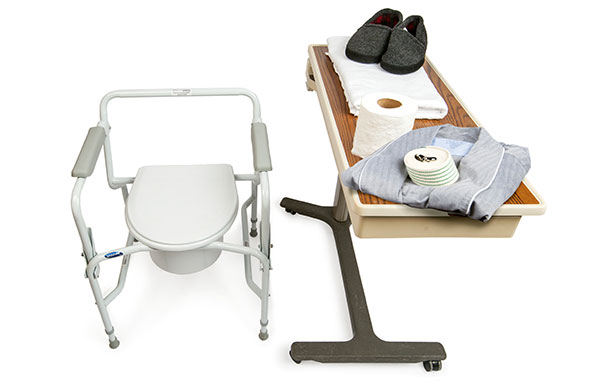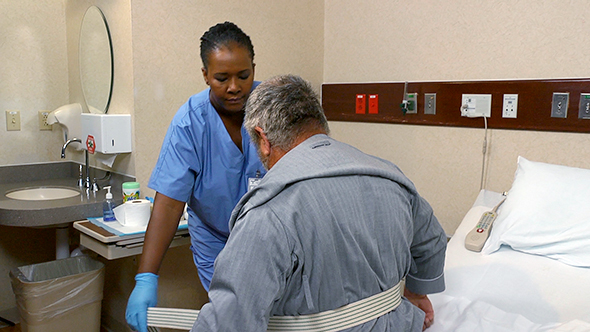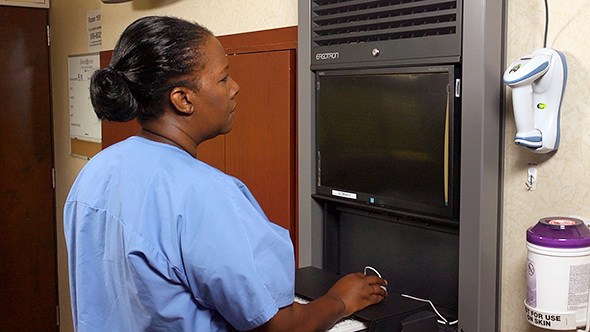Elimination Assistance
Select a Skill:
- » Helping the Person to the Commode
- » Applying Incontinence Products
- » Giving the Urinal
- » Giving the Bedpan
- » Applying a Condom Catheter
- » Giving Catheter Care
- » Emptying a Urinary Drainage Bag
- » Changing a Leg Bag to a Drainage Bag
- » Giving an Enema
- » Changing an Ostomy Pouch
Take the Review Test:

Purpose

- A commode is a chair or wheelchair with an opening for a container. Persons unable to walk to the bathroom often use commodes.
- The commode allows a normal position for elimination. The commode arms and back provide support and help prevent falls.
- Some commodes are wheeled into bathrooms and placed over toilets. They are useful for persons who need support when sitting. The container is removed if the commode is used with the toilet. Wheels are locked after the commode is in position.
Equipment
Roll cursor over items to see labels. For the purposes of clearly depicting the equipment, a barrier is not shown in this photo. When providing care, a barrier should always be placed on the surface before placing the equipment.

Bariatric-size commode
Bath blanket
Robe
Toilet tissue
Transfer belt
Non-skid footwear
Delegation
- Follow delegation guidelines. Before helping the person to the commode, obtain this information from the nurse and care plan:
- If the commode is used at the bedside or over the toilet
- How much help the person needs
- If you can leave the person or if you need to stay with the person
- If the nurse needs to observe urine or feces
- What observations to report and record
- When to report observations
- What patient or resident concerns to report at once
Preparation

- Observe quality-of-life measures.
- Review the information under Delegation and Safety and Comfort.
- Provide for privacy.
- Practice hand hygiene.
- Put on gloves.
- Collect the equipment.
Safety

- For commode use, transfer the person from the bed, chair, or wheelchair to the commode. Practice safe transfer procedures. Use the transfer belt and lock the wheels on the bed, wheelchair, and commode (if it has wheels). Remove the transfer belt after the transfer.
- Urine and feces may contain blood and microbes. Follow Standard Precautions and the Bloodborne Pathogen Standard. Thoroughly clean and disinfect the commode container after use. Clean and disinfect the seat and other commode parts if necessary.
Comfort
- After the person transfers to the commode, cover his or her lap and legs with a bath blanket. This promotes warmth and privacy.
Procedure Video
Audio Description: OFFFollow-up Care

- Provide for comfort.
- Place the call light within reach.
- Raise or lower bed rails. Follow the care plan.
- Unscreen the person.
- Complete a safety check of the room.
- Follow agency policy for dirty linen.
- Practice hand hygiene.
Reporting/Recording
- Report and record your observations, including:
- Color, amount, clarity (or cloudiness), and odor of urine
- Particles or blood in the urine
- Complaints of urinary urgency or burning, dysuria, or other problems
- Color, amount, consistency, and odor of feces
- Signs of blood in feces
- Complaints of pain or discomfort with bowel movement.
Review Questions
Select the best answer.
1. When is a bedside commode used?
 When the person cannot walk to the bathroom
When the person cannot walk to the bathroom When the person refuses to remain in bed and use a bedpan
When the person refuses to remain in bed and use a bedpan When staffing is not sufficient to help the person walk to the bathroom
When staffing is not sufficient to help the person walk to the bathroom When sterile urine and stool specimens are needed from an infected person
When sterile urine and stool specimens are needed from an infected person
Select the best answer.
2. When helping a person to use a commode, what step should you be sure to take?
 Always stay with the person during toileting
Always stay with the person during toileting Use a transfer belt to restrain the person on the commode
Use a transfer belt to restrain the person on the commode Clean and disinfect the commode container weekly to prevent odors
Clean and disinfect the commode container weekly to prevent odors Make sure the signal light is within the person’s reach during toileting
Make sure the signal light is within the person’s reach during toileting
Select the best answer.
3. After transferring the person to the commode, what should you do?
Select the best answer.
4. When helping the person with commode use, what safety measure should you take?
 Clean and disinfect the commode container twice a week
Clean and disinfect the commode container twice a week Follow Standard Precautions and the Bloodborne Pathogen Standard
Follow Standard Precautions and the Bloodborne Pathogen Standard Clean and disinfect the seat and other commode parts after each use
Clean and disinfect the seat and other commode parts after each use Keep the transfer belt in place after transferring the person to the commode
Keep the transfer belt in place after transferring the person to the commode
Select the best answer.
5. For a person who can be left alone on the commode, how frequently should you check on him or her?
You have completed the Review Questions for this skill. To take the Review again select the Start Over button. To proceed to another skill select from the dropdown menu. Select the Home or Back button to proceed to the next section.

